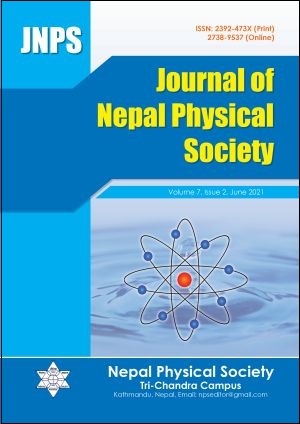Geomagnetically Quiet Period Analysis of Relativistic Electrons, Auroral Precipitation, Joule Heating, and Ring Current During the Years of 1999, 2000 and 2004
DOI:
https://doi.org/10.3126/jnphyssoc.v7i2.38633Keywords:
Auroral Precipitation, Relativistic Electron, Ring Current, Magnetosphere, Joule Heating, Cross-CorrelationAbstract
This work presents the study of the quietest time variation in relativistic electrons, auroral precipitation, ring current, and joule heating during 1999, 2000, and 2004. Geostationary Operational Environmental Satellite (GOES) data on relativistic electrons with energies above 0.6 MeV, 2 MeV, and 4 MeV were analyzed. The time-series analysis of the relativistic electrons over a 24-hour averaged interval reveals a precise 24-hour modulation of the relativistic electron population during all seasons for energies above 0.6 MeV and 2 MeV, and during the winter season for higher energies above 4 MeV. In addition, relativistic electron fluxes at energies above 0.6 MeV and above 2 MeV were higher during the descending phase of the solar cycle compared to the ascending and solar-maximum phases. The cross-correlation analysis presented a strong correlation of Joule heating, ring current, and auroral precipitation with the relativistic electron population in three energy bands considered, as indicated by the zero-time lag. Studying the quiet time variation of relativistic electrons will lead to more complete ionospheric models, which were previously limited to the geomagnetically disturbed period.
Downloads
Downloads
Published
How to Cite
Issue
Section
License
All right reserved. No part of this Journal may be reproduced in any form or by any electronic or mechanical means, including information storage and retrieval system, without permission in writing from the publisher, except by a reviewer who may quote brief passage in a review. The views and interpretation in this journal are those of author(s) and they are not attributable to the NPS.




